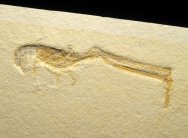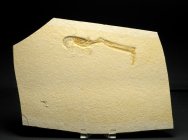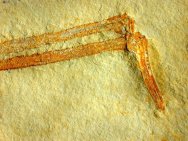Mecochirus
longimanu
Subphylum
Crustacea, Class Malacostraca, Order Decapoda, Superfamily Glypheoidea
Geological
Time: Upper Jurassic
Size: 197
mm
Fossil
Site: Solnhofen Limestone, Eichstatt, Germany "Plattenkalk” Malm Zeta 2, Eichstatt, Germany
|  Description:
This is an unusual member of the lobster family, with elongated first pair of
walking legs that extraordinarily prominent, and the characteristic
from which the species is named, as logimanu means long arm.
Note that the arms are well preserved, some not seen in most
Solnhofen Mecochirus fossils. Description:
This is an unusual member of the lobster family, with elongated first pair of
walking legs that extraordinarily prominent, and the characteristic
from which the species is named, as logimanu means long arm.
Note that the arms are well preserved, some not seen in most
Solnhofen Mecochirus fossils.
As with all members of Malacostraca Order Decapoda, lobsters have 10 legs matched
to the last five of eight pairs of thorax-attached appendages. The three front
pairs function as mouthparts and are called maxillipeds, and the rest are called
pereiopods. Many decapods have large claws called chelae as one leg pair that
are called chelipeds. Further appendages are found on the abdomen, with each
segment capable of carrying a pair of biramous pleopods, the last of which form
part of the tail fan (together with the telson) and are called uropods.
This fossil comes from the famous Solnhofen
lithographic limestone Lagerstätte of
Germany, and world class. These 150 million year old Jurassic strata have long
yielded superb fossils, the most famous of which is the ancient bird Archaeopteryx.
Also
see: Solnhofen Fossils
|
|


